What are Platform Engineering solutions?
Platform Engineering solutions focus on creating internal developer platforms (IDPs) that simplify software development by providing self-service capabilities and automating infrastructure operations. These solutions aim to empower development teams, reduce cognitive load, and accelerate the delivery of value to end-users.
Key aspects of Platform Engineering solutions include:
- Internal developer platforms (IDPs): Platform Engineering revolves around building and maintaining IDPs, which act as a centralized hub for developers to access pre-configured infrastructure components and services.
- Self-service capabilities: IDPs enable developers to self-serve resources and tools, reducing the need for manual intervention and speeding up development cycles.
- Automation: Platform Engineering solutions automate infrastructure provisioning, deployment, and other operational tasks, freeing up developers to focus on building features.
- Standardization and consistency: By providing standardized “golden paths” and reusable components, Platform Engineering promotes consistency and reduces inconsistencies across teams.
- Reduced cognitive load: Abstracting away infrastructure complexities through self-service and automation allows developers to focus on building applications rather than managing infrastructure.
- Improved developer experience: Platform Engineering solutions aim to enhance the overall developer experience by providing tools, resources, and support that simplify the development process.
- Increased efficiency: By automating workflows and providing self-service capabilities, Platform Engineering solutions can significantly improve development efficiency and accelerate time to market.
- Cost optimization: Platform Engineering can help optimize resource usage by providing tools and insights for monitoring and managing infrastructure costs.
Key features and benefits of Platform Engineering solutions
Internal developer platforms (IDPs)
Internal developer platforms (IDPs) are a cornerstone of Platform Engineering. They provide developers with a curated set of tools, resources, and workflows that automate infrastructure, deployment, and monitoring tasks. By consolidating components like source control, CI/CD pipelines, environment management, and observability into a unified platform, IDPs enable developers to focus on building features instead of wrestling with infrastructure.
The main advantage of IDPs lies in their ability to eliminate toil and inconsistencies across teams. Rather than repeating integrations or configurations, development teams use standardized workflows and toolsets via self-service interfaces. This shortens deployment time and ensures that security and compliance policies are consistently enforced by design, reducing risks and operational overhead.
Self-service capabilities
Self-service is a defining trait of effective Platform Engineering solutions. It empowers developers to request and provision resources, deploy code, manage environments, and monitor systems, all without waiting on manual intervention from operations teams. Through automation and clear interfaces, self-service reduces bottlenecks and increases the speed at which teams can deliver software.
One critical benefit is the faster feedback loop: developers can spin up test environments or roll out changes instantly, catching issues early. This autonomy boosts productivity and morale, as engineers spend less time waiting and more time building. Additionally, it allows operations to focus on improving the platform rather than handling individual requests.
Automation
Automation in Platform Engineering eliminates repetitive, error-prone tasks by codifying them into repeatable workflows. Infrastructure provisioning, environment setup, application deployment, and monitoring can all be triggered automatically through pipelines or APIs. This reduces manual effort, speeds up delivery, and ensures that processes are performed the same way every time.
Another benefit of automation is improved reliability and scalability. Platforms can enforce guardrails such as automated policy checks, security scans, and rollback mechanisms without requiring manual approval at every stage. This allows teams to move quickly while maintaining compliance and operational stability.
Standardization and consistency
Standardization is core to Platform Engineering because it enforces organization-wide best practices for infrastructure, deployment, and ongoing operations. By codifying patterns in reusable templates, manifests, and workflows, platforms ensure that all teams follow the same guidelines, simplifying audits, troubleshooting, and onboarding of new staff. Consistency in processes leads to predictable results.
Errors due to misconfiguration or deviation from the standard process are minimized, lowering the risk of outages or security incidents. Furthermore, standardized environments help achieve regulatory compliance since the same controls and checks are applied everywhere, and deviations are easily detected.
Reduced cognitive load
Platform Engineering solutions minimize cognitive load by abstracting away the complexity of underlying systems. Developers no longer need to understand every detail of infrastructure, networking, or security to deploy or operate applications. Instead, they interact with high-level interfaces or APIs that expose only the necessary controls and options.
By reducing mental overhead, engineers can concentrate on solving business problems rather than being sidetracked by the intricacies of pipelines, infrastructure-as-code, or cloud services. This shift accelerates development velocity and helps prevent mistakes from unfamiliarity with operations or configurations outside the developer’s expertise.
Improved developer experience
A primary goal of Platform Engineering is to enhance developer experience (DX). This is achieved through simplified onboarding processes, clear documentation, consistent tooling, and automation that removes manual toil. Developers benefit from faster setup times, reduced friction in day-to-day work, and easy access to logs, metrics, or debugging tools.
Focusing on DX increases developer satisfaction and retention, as engineers feel empowered to build and deliver value without bureaucratic or technical blockers. Modern platforms often incorporate feedback mechanisms, allowing platform teams to iteratively improve interfaces and workflows based on real-world usage and pain points.
Increased efficiency
Efficiency gains from Platform Engineering are realized through automation, best practices, and reduced manual interventions. By centralizing the management of resources and workflows, organizations eliminate waste and prevent duplication of effort among different teams. Automated provisioning, deployment, and rollback capabilities mean tasks get done faster and with fewer errors.
The efficiency impact also extends to operations: with fewer tickets and repetitive support tasks, platform and SRE teams can focus on strategic improvements. Metrics and observability built into platforms offer insight into bottlenecks and performance issues, allowing for continuous optimization at both the application and infrastructure levels.
Cost optimization
Cost optimization is an important benefit of Platform Engineering, stemming from better resource usage and automation. By enforcing resource quotas, automatically shutting down idle environments, and standardizing infrastructure, platforms help prevent over-provisioning and wastage. FinOps practices (financial operations management) are easier to implement at scale with centralized platforms.
Moreover, by automating what would otherwise be labor-intensive operations work, Platform Engineering reduces the need for extensive manual intervention, lowering personnel costs. Cost visibility features built into platforms give teams insights into where and how cloud resources are used, enabling proactive cost management and forecast planning.
Notable Platform Engineering solutions
1. Octopus
Octopus Platform Hub gives platform teams the structure to scale, without the overhead of building and maintaining internal tooling.
With connected templates, enforceable policies, and centralized governance, Platform Hub helps teams define how software gets delivered across environments and teams, while giving developers the autonomy to move fast, safely.
General features include:
- Provides reusable process templates that standardize deployment workflows across teams and projects
- Enables centralized management and version control of deployment patterns to reduce drift and duplication
- Offers policy-based governance using Rego to write custom compliance checks and block non-compliant deployments
- Integrates with existing Octopus Deploy automation capabilities
- Includes audit logging for policy evaluation events and deployment compliance tracking
- Supports project-level standardization while avoiding rigid one-size-fits-all approaches
Enterprise features include:
- Eliminates the need to build and maintain homegrown platform tooling that doesn’t scale
- Reduces engineering overhead through centralized template management and automated policy enforcement
- Enforces consistent, compliant, and auditable deployment practices across all environments
- Provides structured foundation for long-term delivery success with coordinated change management at scale
- Supports governance automation and visibility without creating development bottlenecks
2. Backstage
Backstage is an open source platform originally developed by Spotify to help engineering teams manage the complexity of large-scale software development. It provides a centralized control plane where teams can document, organize, and discover internal services, infrastructure components, and tools.
Key features include:
- Software catalog: Centralizes internal services with metadata, enabling clear ownership, discoverability, and reuse across teams.
- Software templates: Standardizes project creation with reusable blueprints that reflect organizational best practices.
- TechDocs: Lets developers write and manage documentation using a “docs-as-code” model within the same interface.
- Plugin architecture: Extensible with open source plugins to integrate monitoring, CI/CD tools, and IDPs.
- Developer-focused UX: Provides a consistent interface for developers, reducing the need for DevOps expertise.
![]()
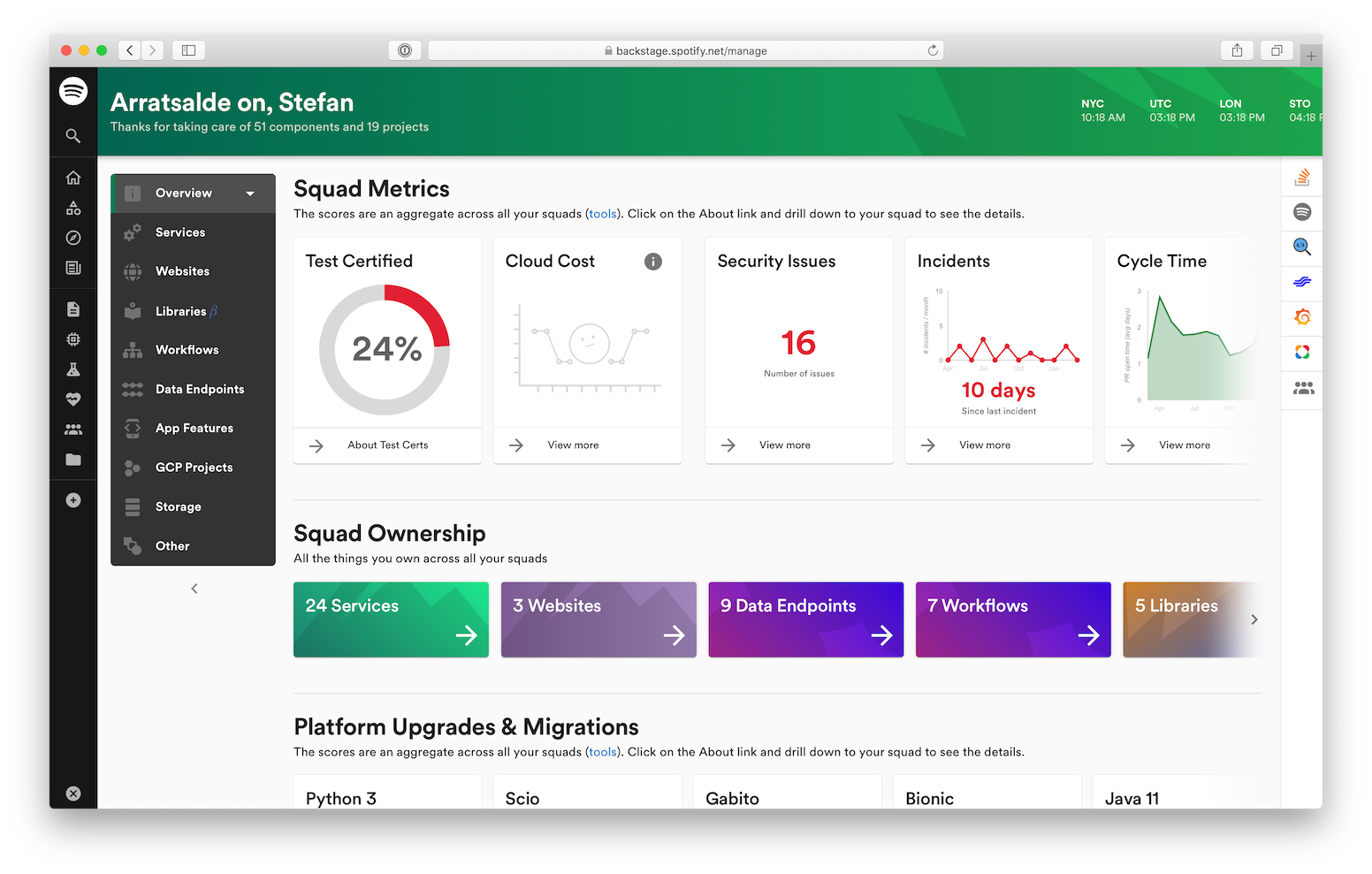
Source: Backstage
3. Humanitec
Humanitec is a platform orchestrator for enterprise internal developer platforms. It enables organizations to simplify software delivery by integrating infrastructure, automating configuration, and supporting true developer self-service.
Key features include:
- Platform orchestration: Connects and automates infrastructure and tooling, enabling platform teams to standardize configurations and provisioning workflows across the organization.
- Dynamic configuration management (DCM): Automates app and infra configuration per deployment using declarative workload specs, improving standardization and separating concerns.
- Developer self-service: Allows developers to request and deploy resources without needing operations support, using Score or Humanitec’s UI, CLI, or API.
- Golden paths and policy enforcement: Enables platform engineers to define reusable patterns and rules that are enforced automatically, reducing errors and increasing compliance.
- Open integration model: Supports integration toolchains like Backstage, ArgoCD, Terraform, and GitOps via open-source drivers and custom extensions.
![]()
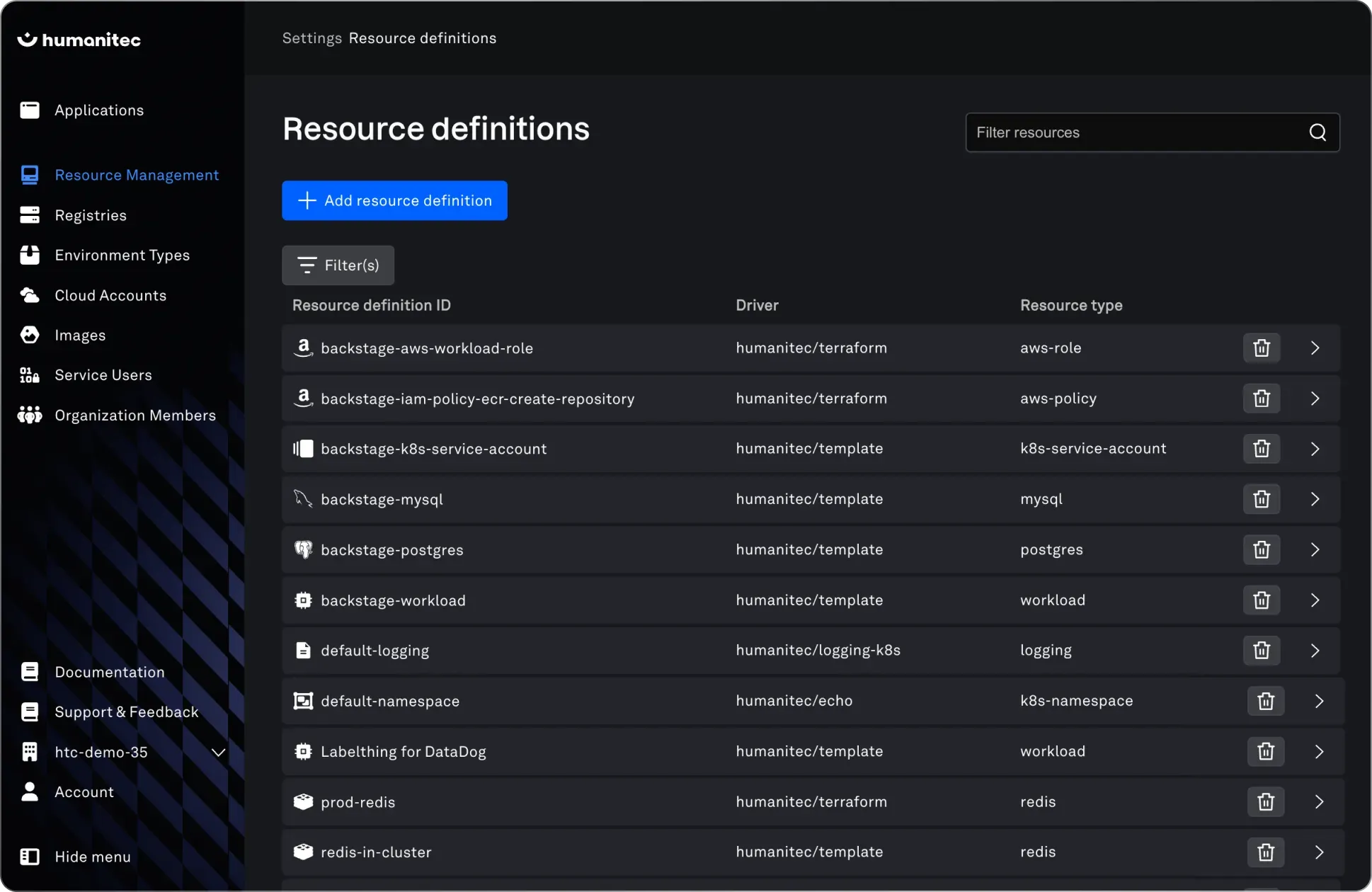
Source: Humanitec
4. Quali Torque
Quali Torque is a SaaS platform to automate the lifecycle of cloud infrastructure from initial provisioning (Day 0) through ongoing management and optimization (Day 2). It helps DevOps, Platform Engineering, and infrastructure teams eliminate repetitive manual work by enabling reusable, codified cloud environments and enforcing continuous governance.
Key features include:
- Environment as code blueprints: Uses YAML-based blueprints to define, deploy, and manage cloud environments by reusing Terraform, Ansible, OpenTofu, Helm, and Kubernetes assets.
- Curated inventory of cloud assets: Automatically discovers infrastructure in Git repositories or public cloud accounts and converts them into reusable, open-source IaC files.
- Self-service provisioning: Provides a simplified, governed self-service catalog for developers, enabling infrastructure deployment using natural-language prompts or standard templates.
- Day 2 operations as code: Enables lifecycle actions like scaling, restarts, or teardown to be defined as code and executed on demand or via custom automation triggers.
- Governance and policy enforcement: Supports fine-grained RBAC, cost controls, and deployment policies to ensure compliance with security and performance standards.
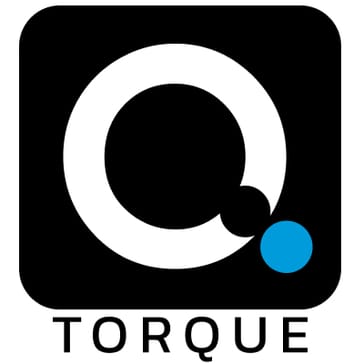
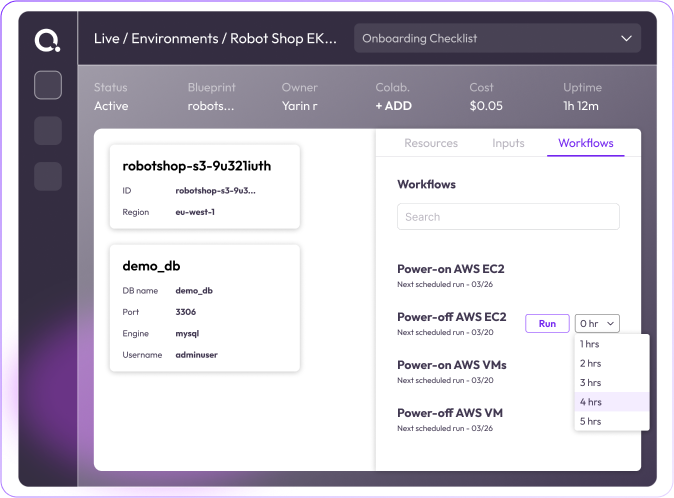
Source: Quali Torque
5. OpsLevel
OpsLevel is an internal developer portal to help engineering teams move faster. It centralizes tools, documentation, and operational workflows, giving developers self-service access to everything they need to build and ship software efficiently. At the same time, it gives platform and SRE teams the ability to enforce best practices and monitor service health.
Key features include:
- Software catalog: Provides an inventory of services, systems, infrastructure, repositories, and domains, ensuring visibility and accurate ownership across the software ecosystem.
- Service maturity and scorecards: Uses health checks and scorecards to gamify compliance with production-readiness standards, encouraging teams to incrementally improve service quality.
- Developer self-service hub: Offers a central place for developers to initiate common tasks like spinning up a new service, rolling back a deployment, or provisioning infrastructure, without needing to submit tickets.
- Template-based workflows: Enables developers to create new services from predefined templates, ensuring consistency and adherence to architectural guidelines.
- Centralized operational access: Consolidates tools and actions, such as running scripts or making API calls, into one interface to reduce time spent switching contexts.
![]()
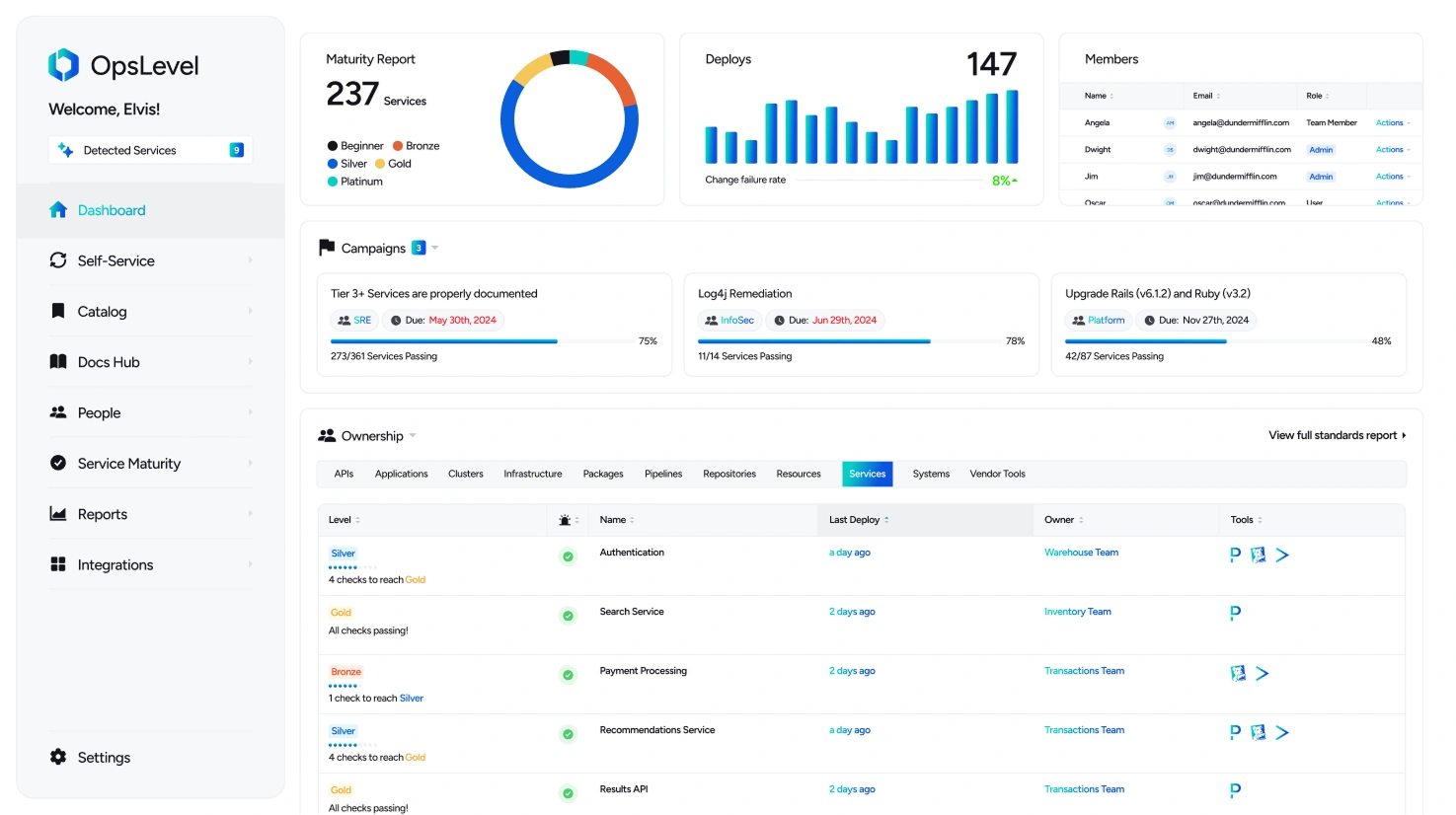
Source: OpsLevel
Conclusion
Platform Engineering solutions provide the foundation for scalable, reliable, and developer-friendly software delivery. By combining self-service capabilities, automation, and standardized workflows, they allow teams to reduce operational friction while maintaining security and compliance. The result is a faster, more efficient path from code to production, with developers empowered to focus on delivering business value rather than managing infrastructure complexity.
Help us continuously improve
Please let us know if you have any feedback about this page.

